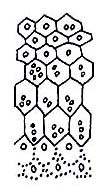ワニトカゲギス科
- HOME
- デジタル図鑑
- パタゴニア海域の重要水族
- 硬骨魚綱 ワニトカゲギス目 ワニトカゲギス科
ワニトカゲギス科(Stomiidae)

18 ヘビトカゲギス(Hebi-tokagegisu)
Stomias boa Risso, 1810
特 徴:
背鰭19〜20軟条,臀鰭18軟条,胸鰭6軟条,腹鰭5軟条,鰓条骨数18。頭長は体長の9.0〜9.4%,眼径は約1.2%,体高は4.5〜6.9%,吻長は1.9〜2.7%,両眼間隔は2.1〜2.2%,上顎長は8.5〜9.5%,尾柄高は1.3〜1.5%,胸鰭長は約8.2%,腹鰭長は約9.6%,背鰭高は4.6〜5.7%,臀鰭高は約4.6%,髭長は10.8〜11.1%。体は細長く側扁し,体長は体高の約16倍。頭は小さく,体長は頭長の約10倍。吻は極めて短く,頭長は吻長の約5倍。両顎はよく発達し,上顎より下顎の方が前方に突出する。口は突出可能。5本の内側に湾曲した牙状歯(うち3本は他より大)が下顎に,4本の内側に湾曲した牙状歯(うち2本は他より大)が上顎に存在する。主上顎骨下面に鋸歯縁を有する。顎髭は柔軟で細長く,先端に黒い細長い柄を持った3つの発光球がある。内側に湾曲した牙状歯が鋤骨上に1対,口蓋骨上に2対ある。背鰭と臀鰭は尾鰭の直前に相対在する。胸鰭は小さく,下位で,鰓蓋後縁直後に位置する。腹鰭は後方に位置し,頭部よりも尾鰭にはるかに近い。体側発光器はよく発達し,配列は胸部前発光器(IP)10,胸部腹側発光器(PV)56,腹部腹側発光器(VAV)16,尾部発光器(AC)14,胸部体側発光器(OV)55,および腹部体側発光器(VAL)15。体側発光器の上方に6列の6角形の鱗状紋が並び,各々の鱗状紋中に数個の小さな発光細胞がある。鱗は微小で脱落し易い。
分 布:
全世界の深海中層にまばらに分布する。
備 考:
本種は2亜種に分けられ:Stomias boa boa Risso, 1810(地中海,東大西洋,南アフリカ沖および太平洋域に分布)とStomias boa ferox Reinhardt, 1842(北大西洋に分布)が認められている(Morrow, 1946)。
(中村 泉)
Material examined:
2 from Argentina (116.5, 154.8 mm SL), FAKU AP 646, 647.
Description:
D 19-20; A 18; P1 6; P2 5; BR 18.
HL 9.0, 9.4% of SL; ED 1.2; BD 4.5, 6.9; SN 1.9, 2.7; IO 2.1, 2.2; UJ 8.5, 9.5; CP 1.3, 1.5; P1L 8.2; P2L 9.6; DH 4.6, 5.7; AH 4.6; Barbel L 10.8, 11.1.
Body slender, its length about 16 times of its depth, and very compressed. Head about 10 in SL. Snout very short about 5 in HL. Jaws well developed, lower jaw larger and more projected than upper jaw. Mouth protractile. Four fang-like teeth curving inward in which two are larger than others on upper jaw and five fang-like teeth curving inward, in which three are larger on lower jaw. Maxilla with saw-like serrations. Mental barbel slender, flexible, its length about equal to HL. Luminous bulb with three slender, blackish, simple filaments at terminal of barbel. Fang-like teeth curving inward, one pair on vomer and two pairs on palatine. Dorsal and anal fins placed far posteriorly, close to caudal fin. Pelvic fin base nearer to caudal fin than to head. Pectoral fin placed low on body, immediately behind gill-opening. Luminous organs well developed: IP 10; PV 56; VAV 16; AC 14; OV 55; VAL 15. Photophore pattern on side of body froming six longitudinal rows, each pattern marked by a regular hexagonal pigmented area containing one or more small photophores. Body black to dark brown. Fins pale in preserved specimens. Barbel stem pale, one dark spot at base of bulb. Bulb pale, filament blackish.
Distribution:
Worldwide, bathypelagic waters.
Remarks:
Subspecies, Stomias boa boa Risso, 1810 from the Mediterranean, and East Atlantic, off South Africa and the Pacific and Stomas boa ferox Reinhardt, 1842 from the North Atlantic are recognized by Morrow(1964).
(Izumi NAKAMURA)

Distribution of Stomias boa in Patagonia.

Scale and photophore patterns.
- 1
- 2